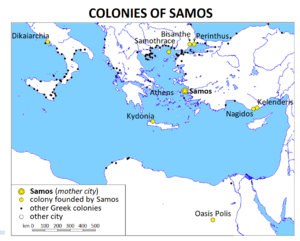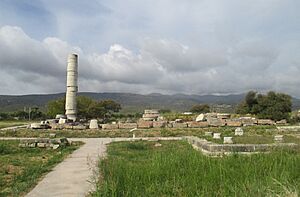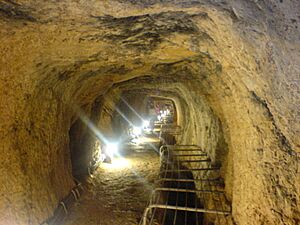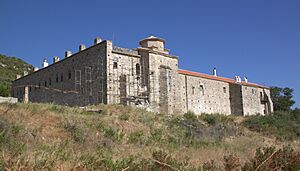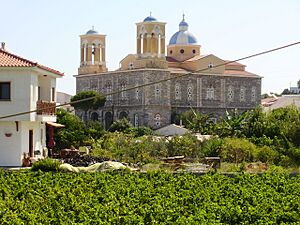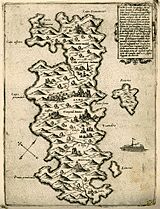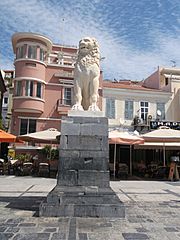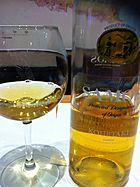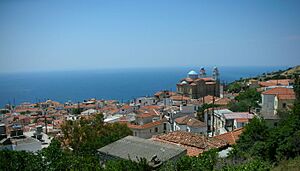Samos facts for kids
Quick facts for kids
Samos
Περιφερειακή ενότητα
Σάμου |
|
|---|---|
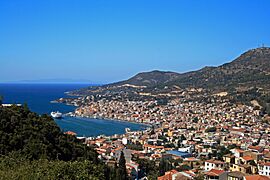
Samos (town), capital of Samos
|
|
| Country | Greece |
| Administrative region | North Aegean |
| Area | |
| • Total | 477.4 km2 (184.3 sq mi) |
| Highest elevation | 1,434 m (4,705 ft) |
| Population
(2021)
|
|
| • Total | 32,642 |
| • Density | 68.375/km2 (177.089/sq mi) |
| Demonym(s) | Samian, Samiot |
| Time zone | UTC+2 (EET) |
| • Summer (DST) | UTC+3 (EEST) |
| Postal code |
831 xx
|
| Area code(s) | 2273 |
| Vehicle registration | MO |
Samos is a beautiful Greek island in the eastern Aegean Sea. It's located south of Chios and north of Patmos. The island is also very close to western Turkey, separated by a narrow strait called the Mycale Strait, which is only about 1.6 kilometers (1 mile) wide. Samos is also a special regional unit within the North Aegean region of Greece.
In ancient times, Samos was a very rich and powerful city-state. It was especially famous for its vineyards and delicious wine. The island is home to two amazing ancient sites: Pythagoreion and the Heraion of Samos. These are so important that they are a UNESCO World Heritage Site. This site also includes the Eupalinian aqueduct, which was a truly incredible piece of ancient engineering.
Samos is the birthplace of many famous people. These include the Greek philosopher and mathematician Pythagoras. You might know him from the Pythagorean theorem in math class! Other famous thinkers from Samos are Melissus of Samos and Epicurus. The astronomer Aristarchus of Samos was also born here. He was the first person known to suggest that the Earth goes around the Sun. Samian wine was popular long ago and is still made on the island today.
From 1835 until 1913, Samos was a special self-governing area called the Principality of Samos. It was under the rule of the Ottoman Empire but had its own leaders. In March 1913, Samos officially became part of Greece.
Contents
What's in a Name?
The name Samos might come from an old Phoenician word, sama. This word means "high."
Island Geography
Samos is about 477 square kilometers (184 square miles) in size. It is about 43 kilometers (27 miles) long and 13 kilometers (8 miles) wide. The island is separated from Anatolia (part of Turkey) by the narrow Mycale Strait. Samos is mostly mountainous, but it also has some large, fertile plains where crops can grow.
A big part of the island is covered with vineyards. These are used to make Muscat wine. The most important plains are around the capital, Vathy, in the northeast. Other plains are near Karlovasi in the northwest, Pythagoreio in the southeast, and Marathokampos in the southwest. About 33,814 people live on Samos, making it the 9th most populated Greek island.
Samos has a typical Mediterranean climate. This means it has mild, rainy winters and warm, dry summers.
The island has two main mountains: Ampelos and Kerkis. The Ampelos mountain range is larger and is in the center of the island. It reaches a height of 1,095 meters (3,593 feet). Mount Kerkis is smaller but taller. Its peak is the highest point on the island, at 1,434 meters (4,705 feet). These mountains are connected to the Mycale range on the Turkish mainland.
Island Animals
Samos is home to many different animals. You might find the golden jackal and the stone marten here. There are also wild boars. If you look towards the sea, you might spot flamingos or even the monk seal.
Samos Climate
Samos has a hot-summer Mediterranean climate. This means it has mild, wet winters and hot, dry summers. The highest temperature ever recorded was 43.0°C (109.4°F). The lowest was -3.4°C (25.9°F). July is usually the hottest and driest month. February is the coldest, and December gets the most rain. Samos receives about 705 millimeters (27.8 inches) of rain each year. The average yearly temperature is 18.4°C (65.1°F).
| Climate data for Samos Airport, Greece (1978-2010) | |||||||||||||
|---|---|---|---|---|---|---|---|---|---|---|---|---|---|
| Month | Jan | Feb | Mar | Apr | May | Jun | Jul | Aug | Sep | Oct | Nov | Dec | Year |
| Record high °C (°F) | 20.4 (68.7) |
21.6 (70.9) |
25.0 (77.0) |
30.0 (86.0) |
36.4 (97.5) |
39.6 (103.3) |
43.0 (109.4) |
41.4 (106.5) |
37.2 (99.0) |
36.0 (96.8) |
27.2 (81.0) |
23.0 (73.4) |
43.0 (109.4) |
| Mean daily maximum °C (°F) | 13.5 (56.3) |
13.5 (56.3) |
15.9 (60.6) |
19.7 (67.5) |
24.9 (76.8) |
30.1 (86.2) |
33.0 (91.4) |
32.8 (91.0) |
28.6 (83.5) |
23.5 (74.3) |
18.4 (65.1) |
15.0 (59.0) |
22.4 (72.3) |
| Daily mean °C (°F) | 10.3 (50.5) |
10.0 (50.0) |
12.1 (53.8) |
15.9 (60.6) |
20.6 (69.1) |
25.5 (77.9) |
28.4 (83.1) |
27.9 (82.2) |
24.3 (75.7) |
19.4 (66.9) |
14.5 (58.1) |
11.9 (53.4) |
18.4 (65.1) |
| Mean daily minimum °C (°F) | 7.2 (45.0) |
6.9 (44.4) |
8.4 (47.1) |
11.1 (52.0) |
14.9 (58.8) |
19.5 (67.1) |
22.8 (73.0) |
22.8 (73.0) |
19.2 (66.6) |
15.5 (59.9) |
11.3 (52.3) |
8.8 (47.8) |
14.0 (57.2) |
| Record low °C (°F) | −2.4 (27.7) |
−3.4 (25.9) |
−1.0 (30.2) |
2.5 (36.5) |
7.4 (45.3) |
8.8 (47.8) |
14.8 (58.6) |
16.4 (61.5) |
12.2 (54.0) |
7.0 (44.6) |
1.0 (33.8) |
−1.4 (29.5) |
−3.4 (25.9) |
| Average precipitation mm (inches) | 135.0 (5.31) |
105.5 (4.15) |
76.4 (3.01) |
40.2 (1.58) |
19.8 (0.78) |
1.6 (0.06) |
0.5 (0.02) |
0.5 (0.02) |
16 (0.6) |
35.8 (1.41) |
116.4 (4.58) |
156.8 (6.17) |
704.5 (27.69) |
| Average precipitation days | 12.4 | 10.4 | 8.6 | 7.4 | 4.0 | 1.1 | 0.2 | 0.1 | 1.4 | 4.6 | 9.3 | 13.7 | 73.2 |
| Average relative humidity (%) | 70.2 | 68.1 | 67.5 | 64.4 | 59.1 | 50.5 | 43.7 | 46.0 | 51.6 | 62.2 | 68.6 | 72.6 | 61.3 |
| Source 1: Hellenic National Meteorological Service (temperature and precipitation days) | |||||||||||||
| Source 2: NOAA (precipitation, and extremes), Info Climat extremes 1991-present | |||||||||||||
Island History
Ancient Times
In ancient times, Samos was a major center for Ionian culture. It was known for its luxury goods, especially Samian wines and a type of red pottery. The most famous building was the ancient Temple of the goddess Hera, known as the Heraion of Samos.
Samos became one of the twelve members of the Ionian League. By the 7th century BC, it was one of the most important trading centers in Greece. This was partly because of its location near trade routes. Samians traded with areas around the Black Sea, Egypt, and other Greek cities. They also founded many colonies in different places.
Samos became very powerful around 535 BC under a ruler named Polycrates. He built up the city with public works. Samos also had a strong navy that helped protect it and control the Aegean Sea.
Eupalinian Aqueduct
During Polycrates' rule in the 6th century BC, a clever engineer named Eupalinos led a project to dig a tunnel through Mount Kastro. This tunnel was part of an aqueduct that brought fresh water to the ancient capital of Samos. It was very important for defense, as enemies couldn't easily cut off the water supply if it was underground.
Eupalinos's tunnel is special because it was one of the earliest tunnels in history to be dug from both ends at the same time. It is over 1 kilometer (0.6 miles) long. Today, this underground aqueduct is seen as a masterpiece of ancient engineering. It is now part of the UNESCO World Heritage Site called the Pythagoreion.
Persian Wars and Rule
After Polycrates died, Samos faced a difficult time. The Persian Achaemenid Empire conquered the island. In 499 BC, Samos joined other Ionian cities in a revolt against Persia. Later, in 479 BC, Samians helped lead a revolt against Persia during the Battle of Mycale.
Samian War
Samos was an important ally of Athens in the Delian League. But in 440 BC, Samos had a disagreement with Miletus, and Athens sided against Samos. This led Samos to rebel. Samos fought against a large Athenian fleet led by Pericles. After a long siege, Samos had to give up. Athens punished Samos, but not as harshly as other rebellious states. Samos had to pay back the costs of the rebellion to Athens.
Peloponnesian War
During the Peloponnesian War (431–404 BC), Samos supported Athens against Sparta. Samos allowed the Athenian fleet to use its port. After Athens lost the war, Samos was again controlled by a small group of powerful people.
Later, Samos became independent again. But by 387 BC, it was back under Persian control. Athens took it back in 366 BC.
Famous Ancient Samians
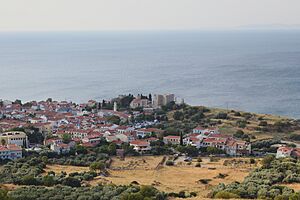
Some of the most famous people from ancient Samos were the philosopher and mathematician Pythagoras and the storyteller Aesop. In 1955, the town of Tigani was renamed Pythagoreio to honor the philosopher.
Other important people include the philosophers Melissus of Samos and Epicurus. The astronomer Aristarchus of Samos was also from Samos. He was the first to suggest that the Earth revolves around the Sun. The famous historian Herodotus lived in Samos for a while.
Samos also had a famous school of sculptors and architects. This included Rhoecus, who designed the Temple of Hera (Olympia). Another great sculptor was Theodorus, who is said to have invented a way to cast statues in bronze with Rhoecus.
Later Eras
For a time, Samos was used as a base for the Egyptian fleet. Later, it was controlled by the Seleucid Empire. In 189 BC, the Romans gave Samos to the kingdom of Pergamon.
From 133 BC, Samos became part of the Roman province of Asia Minor. It was known as a health resort and for making pottery.
After the 13th century, Samos was part of the Byzantine Empire. It also came under the control of the Genoese family Giustiniani for a period.
Ottoman Rule
Samos came under Ottoman rule around 1475. At this time, the island was almost empty because of pirates and a plague. About a century later, the Ottomans worked to bring people back to the island. They offered special benefits, like not having to pay taxes for seven years. This helped the island recover. By the 17th century, about 10,000 people lived there.
Ottoman rule was paused from 1771 to 1774 when Russia controlled the island during a war. After the war, Samian merchants became very active in trade. This led to new ideas from the Age of Enlightenment and the French Revolution reaching Samos.
Greek Revolution

In March 1821, the Greek War of Independence began. Samos joined the fight on April 18, led by Lykourgos Logothetis. A new government with its own rules was set up on the island.
The Samians successfully stopped three Ottoman attempts to take back the island. In 1828, Samos became part of the new Greek state. However, a treaty in 1830 said Samos should not be part of independent Greece.
The Samians did not want to be under the Sultan again. Logothetis declared Samos an independent state. But in 1834, an Ottoman fleet forced them to accept being an autonomous principality. Many leaders and people fled to independent Greece.
Autonomous Principality

From 1834, Samos became the Principality of Samos. It was a semi-independent state that paid a yearly sum to Ottoman Turkey. It was led by a Christian prince chosen by the Ottoman government. The prince worked with a 4-member senate and a chamber of 36 representatives. The main town was Vathý.
The old capital of the island was Chora. But later, the capital moved to Vathy, which had a deep bay and a good harbor. This became the main center for the government.
Modern Times
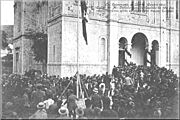
Samos officially joined the Kingdom of Greece in March 1913. This happened during the First Balkan War. Greek troops landed on the island, and the Ottoman soldiers left. Samos was safely in Greek hands by March 16.
During World War II, the island was occupied by Italian forces in May 1941. Samos suffered from a severe famine in 1941–42, which caused many deaths and forced people to leave. After Italy surrendered in 1943, British and Greek forces briefly took over. However, the island was later taken by German forces. The Germans destroyed the harbors of Karlovasos and Ormos Marathokampos. Samos was finally freed on October 5, 1944.
After the war, Samos was a center of resistance during the Greek Civil War. The last resistance unit surrendered in 1949.
On August 3, 1989, a plane crashed near Samos Airport, and 31 people died.
Today, Samos has a large camp for migrants who cross the strait from Turkey. In April 2020, the camp held many more people than it was built for. The Greek government plans to build a new, better center.
On October 30, 2020, a strong earthquake hit near the island. It caused a tsunami. Two people died in Samos, and many buildings were damaged in Vathy and Karlovasi.
Island Economy
The economy of Samos mostly relies on farming and tourism. Tourism has grown a lot since the 1980s. The main farm products include grapes, honey, olives, olive oil, citrus fruit, dried figs, almonds, and flowers. The Muscat grape is the most important crop for making wine. Samian wine is exported around the world.
Local Cuisine
Here are some special foods you can find on Samos:
- Bourekia (a type of pastry)
- Katimeria
- Armogalo cheese
- Katádes (a dessert)
- Moustalevria (a dessert made from grape must)
- Muscat of Samos (the famous wine)
- Tiganites (pancakes)
UNESCO World Heritage Site
Samos is home to two UNESCO World Heritage Sites: the Heraion of Samos and the Pythagoreion. These sites were added to UNESCO's list in 1992 because of their historical importance.
Famous People from Samos
Ancient Figures
- Aesop, a famous storyteller
- Aristarchus of Samos (3rd century BC), an astronomer and mathematician who suggested the Earth goes around the Sun.
- Conon of Samos, an astronomer and mathematician
- Duris of Samos (4th-3rd century BC), a historian
- Epicurus (4th century BC), a philosopher who started the Epicurean school of thought.
- Melissus of Samos, a philosopher
- Polycrates (6th century BC), a powerful ruler of Samos.
- Pythagoras (6th century BC), a famous philosopher and mathematician, known for the Pythagorean theorem.
- Rhoecus (6th century BC), a sculptor and architect.
- Theodorus (6th century BC), a sculptor and architect.
Modern Figures
- Lykourgos Logothetis (1772–1850), a leader of the Samians during the Greek Revolution of 1821.
- Ion Ghica (1816–1897), a Romanian revolutionary and prime minister, who was also a prince of Samos.
- Themistoklis Sofoulis (1860–1949), a politician who became the Prime Minister of Greece.
- Kostas Roukounas (1903–1984), a singer of Rebetika music.
- Nikos Stavridis (1910–1987), an actor.
Images for kids
See also
 In Spanish: Samos para niños
In Spanish: Samos para niños





